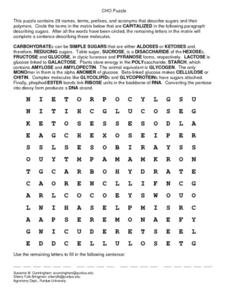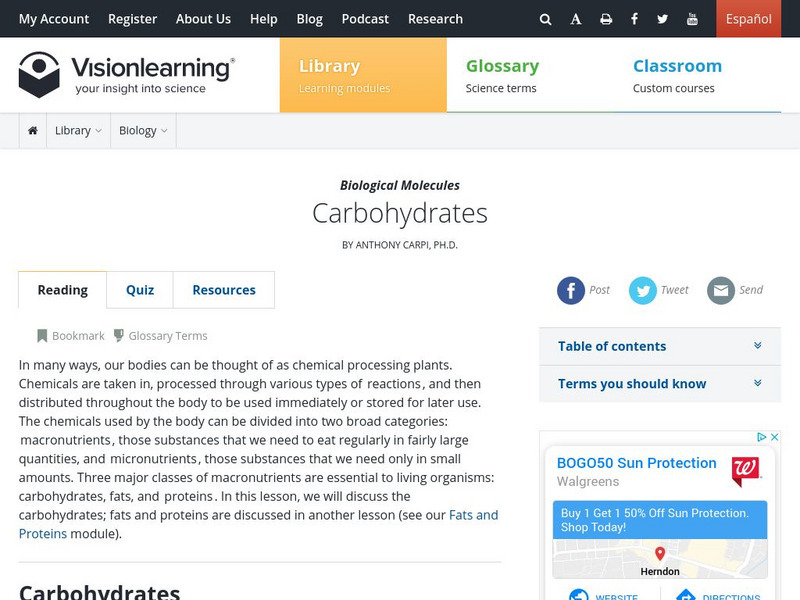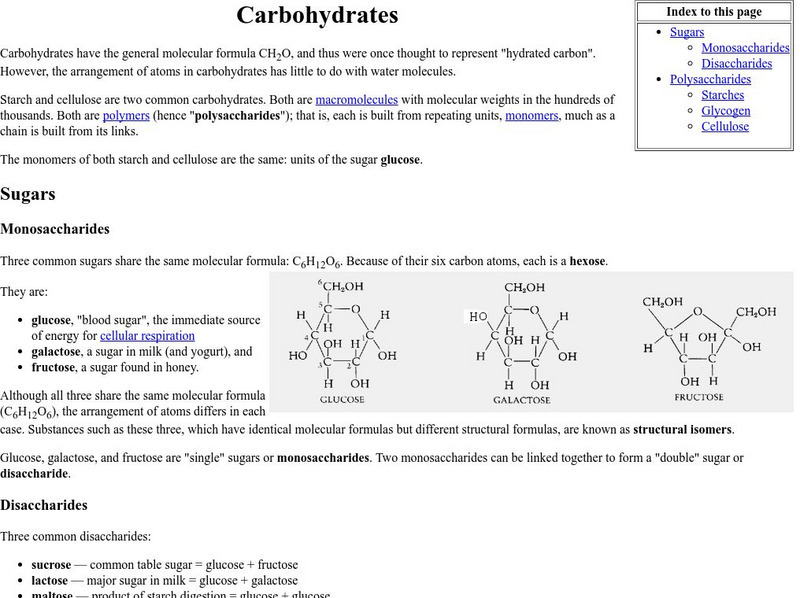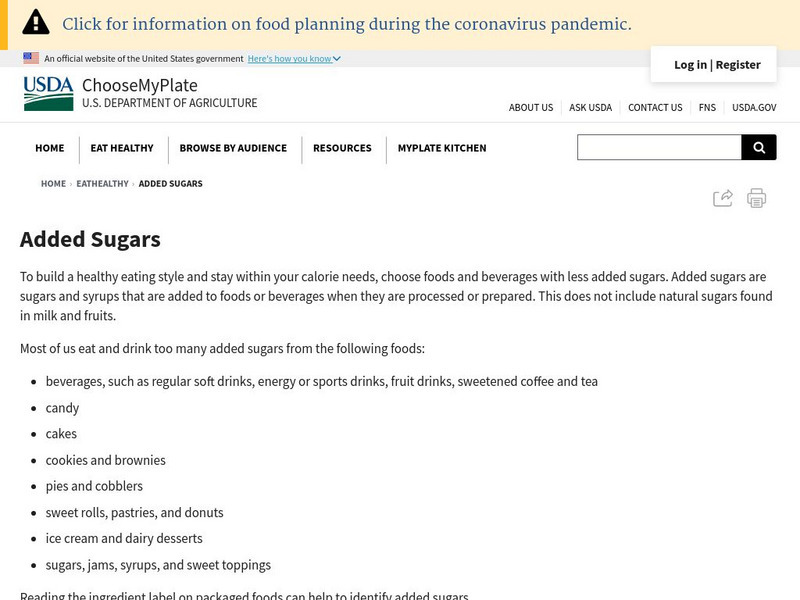Curated OER
AP: Chapter 36: Transport in Plants
When you need a review worksheet for your AP biologists on water and nutrient transport in plants, this one is for you! From the simple stuctures involved to the complex mechanisms that make it happen, the details of transport are...
Curated OER
CHO Puzzle
In this sugar worksheet, young scholars complete a puzzle by circling all the words in the puzzle related to sugars. The remaining letters in the puzzle create a sentence describing the sugar molecules.
Curated OER
Biologically Important Molecules
In this biologically important molecules worksheet, students fill in the blank with information about carbohydrates, lipids, and proteins. Students also make notes about nucleic acids.
Curated OER
Claire Damarodas
Fifth graders examine how sugars may be listed as an ingredient in various ways. E.g. Many of the words end in -ose (ex. Sucrose, dextrose, maltose)
Curated OER
ON THE LOOKOUT FOR LABELS
Students practice reading and using label information and understand the purpose of food labeling. They complete surveys using labels from the products brought in. After discussing the pros and cons of having a law that requires fast...
Science Buddies
Science Buddies: Maple Syrup: For Pancakes, Waffles, and Crystal Candy?
Maple syrup is deliciously gooey and great on breakfast foods like pancakes and waffles. But it has another amazing property. It can form crystals under the right circumstances, and the crystals change in size and shape, depending on...
Science Buddies
Science Buddies: Study Chirality With a Homemade Polarimeter
Some molecules can be either left- or right-"handed." The left- and right-handed molecules have the same number and type of atoms, and their chemical structures look identical, but they are actually mirror images of each other. Many...
Vision Learning
Visionlearning: Biological Molecules: Carbohydrates
An explanation of why carbohydrates are important nutrients for the human body. Chemical formulas and structures are used to demonstrate simple and complex carbohydrates.
American Chemical Society
Middle School Chemistry: Why Does Water Dissolve Sugar?
Explore this animation to learn why water dissolves sugar.
Wikimedia
Wikipedia: Disaccharide
Wikipedia provides a brief description of disaccharides, including hyperlinked terms and examples.
Vision Learning
Visionlearning: Food Chemistry: Carbohydrates
Read about carbohydrates, which make up one of the three "Major classes of macronutrients that are essential to living organisms." In addition to defining several terms, including carbohydrate, simple sugars, complex carbohydrates,...
Ohio State University
Ohio State University: Lipids and Carbohydrates
An introduction to these chemical families. Diagrams are easy to understand and the text explains basic concepts well.
Sophia Learning
Sophia: Disaccharides: Lesson 2
This lesson will introduce disaccharides, including an overview of their structure, and providing multiple examples. It is 2 of 4 in the series titled "Disaccharides."
Biology Pages
Kimball's Biology Pages: Carbohydrates
This is a rather advanced site outlining carbohydrates, and their various forms.
Sophia Learning
Sophia: Disaccharides: Lesson 3
This lesson will introduce disaccharides, including an overview of their structure, and providing multiple examples. It is 3 of 4 in the series titled "Disaccharides."
Sophia Learning
Sophia: Disaccharides: Lesson 4
This lesson will introduce disaccharides, including an overview of their structure, and providing multiple examples. It is 4 of 4 in the series titled "Disaccharides."
Sophia Learning
Sophia: Disaccharides: Lesson 1
This lesson will introduce disaccharides, including an overview of their structure, and providing multiple examples. It is 1 of 4 in the series titled "Disaccharides."
Sophia Learning
Sophia: Structure and Function of Macromolecules: Carbohydrates: Lesson 2
This lesson presents how the structure and function of carbohydrates pertain to living things. It is 2 of 2 in the series titled "Structure and Function of Macromolecules: Carbohydrates."
US Department of Agriculture
Choose My Plate: What Are "Added Sugars"?
In addition to providing a definition of "added sugars," this website includes examples of foods that contain added sugars and different names for added sugars that you can find while reading food labels.
Other
Chemistry Explained: Artificial Sweeteners
Discusses four artificial sweeteners that have been approved by the U.S. Food and Drug Administration (FDA). These include saccharin, aspartame, acesulfame K, and sucralose.
Sophia Learning
Sophia: Structure and Function of Macromolecules: Carbohydrates: Lesson 1
This lesson presents how the structure and function of carbohydrates pertain to living things. It is 1 of 2 in the series titled "Structure and Function of Macromolecules: Carbohydrates."





















